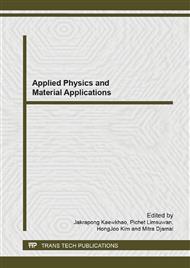p.153
p.157
p.161
p.165
p.169
p.173
p.177
p.181
p.185
Nitrogen – Doped SnO2 Thin Films Prepared by Direct Current Magnetron Sputtering
Abstract:
Nitrogen - doped tin oxide (N-doped SnO2) thin films were prepared on unheated glass substrate by dc magnetron sputtering of a Sn target in gas mixtures of O2 and N2. The N2 flow rates were varied from 0 to 15 SCCM with the same working pressure of 1×10-2 Torr. The as-deposited films were annealed in vacuum at 400 °C for 1 h. The films structure, electrical properties and optical properties were characterized by X-ray diffraction (XRD), 4-point probe and Hall effect measurement and portable fiber optic UV-vis spectrometer, respectively. The observed XRD patterns of films showed preferred (101) orientation of the SnO2 tetragonal structure. The average crystalline size of the (101) diffraction peak decreased from 5.10 to 4.07 nm with N2 flow rate increased. Hall measurement indicated that resistivity increased and carrier concentrations decreased as N2 flow rate increased. The carrier concentrations decreased because N atoms substituted oxygen atom in SnO2 lattice. The N atoms may forms acceptor level in SnO2 band gap resulting in hole generation. The electron concentration from intrinsic defect were neutralized with the hole concentration. The carrier concentration decreased from 3.42×1017 cm-3 for un-doped SnO2 to the order of 1014 cm-3. The average percent transmittance of un-doped SnO2 of about 77.5% in visible range (400-700 nm) decreased to 60% with increasing N2 flow rate. The optical band gap decreased from 3.64 eV for un-doped SnO2 to 3.45 eV for N-doped SnO2 films.
Info:
Periodical:
Pages:
169-172
Citation:
Online since:
September 2013
Keywords:
Price:
Сopyright:
© 2013 Trans Tech Publications Ltd. All Rights Reserved
Share:
Citation:


